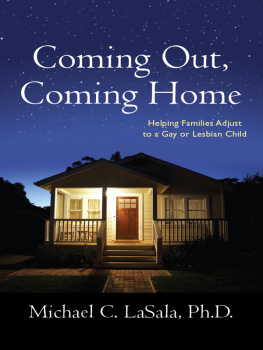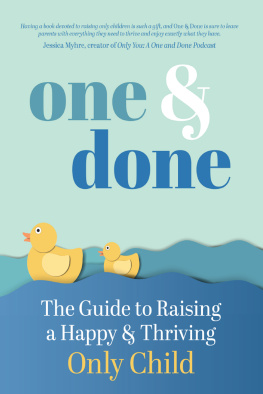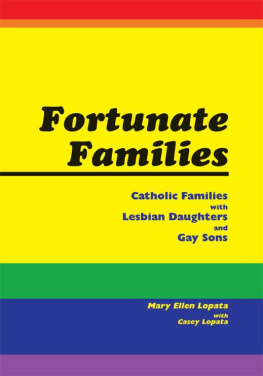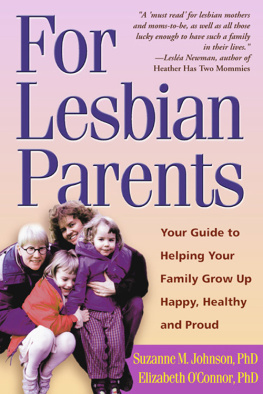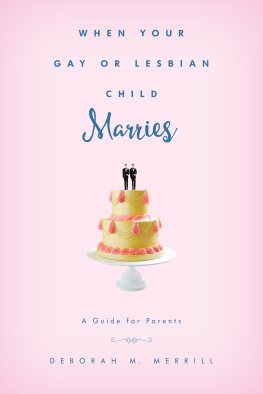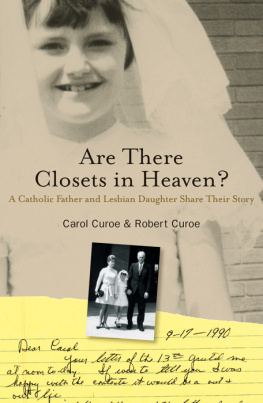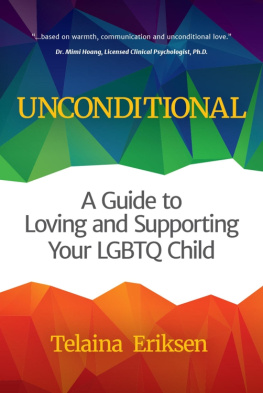LaSala - Coming out, coming home helping families adjust to a gay or lesbian child
Here you can read online LaSala - Coming out, coming home helping families adjust to a gay or lesbian child full text of the book (entire story) in english for free. Download pdf and epub, get meaning, cover and reviews about this ebook. City: New York, year: 2010;2011, publisher: Columbia University Press, genre: Home and family. Description of the work, (preface) as well as reviews are available. Best literature library LitArk.com created for fans of good reading and offers a wide selection of genres:
Romance novel
Science fiction
Adventure
Detective
Science
History
Home and family
Prose
Art
Politics
Computer
Non-fiction
Religion
Business
Children
Humor
Choose a favorite category and find really read worthwhile books. Enjoy immersion in the world of imagination, feel the emotions of the characters or learn something new for yourself, make an fascinating discovery.
- Book:Coming out, coming home helping families adjust to a gay or lesbian child
- Author:
- Publisher:Columbia University Press
- Genre:
- Year:2010;2011
- City:New York
- Rating:5 / 5
- Favourites:Add to favourites
- Your mark:
- 100
- 1
- 2
- 3
- 4
- 5
Coming out, coming home helping families adjust to a gay or lesbian child: summary, description and annotation
We offer to read an annotation, description, summary or preface (depends on what the author of the book "Coming out, coming home helping families adjust to a gay or lesbian child" wrote himself). If you haven't found the necessary information about the book — write in the comments, we will try to find it.
LaSala: author's other books
Who wrote Coming out, coming home helping families adjust to a gay or lesbian child? Find out the surname, the name of the author of the book and a list of all author's works by series.
Coming out, coming home helping families adjust to a gay or lesbian child — read online for free the complete book (whole text) full work
Below is the text of the book, divided by pages. System saving the place of the last page read, allows you to conveniently read the book "Coming out, coming home helping families adjust to a gay or lesbian child" online for free, without having to search again every time where you left off. Put a bookmark, and you can go to the page where you finished reading at any time.
Font size:
Interval:
Bookmark:
COMING OUT, COMING HOME
Coming Home
to a Gay or Lesbian Child
Michael C. LaSala, Ph.D.
COLUMBIA UNIVERSITY PRESS NEW YORK

COLUMBIA UNIVERSITY PRESS
Publishers Since 1893
New York Chichester, West Sussex
cup.columbia.edu
Copyright 2010 Columbia University Press
All rights reserved
E-ISBN 978-0-231-51299-2
Library of Congress Cataloging-in-Publication Data
LaSala, Michael C.
Coming out, coming home: helping families adjust to a gay or lesbian child / Michael C. LaSala, Ph.D.
p. cm.
Includes bibliographical references and index.
ISBN 978-0-231-14382-0 (cloth: alk. paper) ISBN 978-0-231-14383-7 (pbk.: alk. paper) ISBN 978-0-231-51299-2 (e-book)
1. Parents of gays. 2. GaysFamily relationships. 3. Parent and child. I. Title.
HQ76.25.L36 2010
306.874dc22
2009045335
A Columbia University Press E-book.
CUP would be pleased to hear about your reading experience with this e-book at .
References to Internet Web sites (URLs) were accurate at the time of writing. Neither the author nor Columbia University Press is responsible for Web sites that may have expired or changed since the book was prepared.
THIS BOOK IS DEDICATED TO
my parents, Michael LaSala and Carole Guardino LaSala,
my brother, Jaime LaSala,
my partner, Timothy Murphy,
the families in this study,
and all other sources of unconditional love.
M ICHAEL LASALA HAS WRITTEN A LANDMARK STUDY OF the experiences and relationships of parents and their children in the coming-out process. It is a moving exploration of families working through the disruption of finding out their children are homosexual. Parents, as LaSala describes, agonize that their children will be unsafe as they launch them into a world where gay and lesbian youth are discriminated against, assaulted, even murdered. The important news is that parents can buffer the effects of these harsh realities, so LaSalas book is essential reading for all clinicians working to facilitate family development and connectedness.
LaSalas narrative challenges many of the myths about family relationships before, during, and after the coming-out process, such as the myth that families cannot be close before they are open about their childs homosexuality. He conveys with touching descriptions that even though there is avoidance about the homosexuality, parents and children may be very caring and connected on many levels. What impressed and humbled him in doing the study, he says, is the way the parents and children held on to each other and even grew closer despite their fears and shattered expectations. Children must try to figure out their own identities while working to stay connected to parents on whom they are still reliant for emotional and financial support, while parents go through a maelstrom of feelings during this phase. LaSala was awestruck by the depth and persistence of family connections, which led him to reflect on the mysterious ties that bind families together. Reading his book, I was similarly awestruck by the power, mystery, and persistence of families to stay connected in spite of everything. It also made me feel the tragedy and loss of those families not included in this study, those who could not appreciate the importance of family relationships and do not manage to stay connected. I wish they would read this book and realize what they are missing.
LaSalas writing is refreshing, with humor and tenderness for the parents and children in these sixty-five families. He found these families stories went beyond the stereotypical narrative that children are victims of parents negative attitudes toward homosexuality and that once the parents are educated they relate better and relationships improve. LaSala achieved a broader understanding of the experiences of children and parents in the coming-out process.
The larger context for these families is, of course, facing the fear, shame, ostracism, and rejection from societal groups: religious, cultural, and social. The courageous effort of so many parents in this book to hold on to their own values and relationships in spite of such pernicious societal pressures is inspiring. LaSala discusses what has been called homosexual stigmasocietys shared belief system through which homosexuality is denigrated, discredited, and constructed as invalid relative to heterosexuality (Herek, Chop, and Strohl 2007:171). We have to remember it is only a few decades ago that the Diagnostic Manual ceased to call homosexuality a mental illness. Families live in the shadow of such societal negativity. The devastating impact of peer abuse, religious and societal intimidation and condemnation is hard to overcome. So every family here has a courage that must be appreciated.
LaSala has a deep understanding of family process. He explores with rich understanding the relationships of the parents and children in his study. As he describes the love of mothers he says, It is hard to imagine anything quite as soothing for a distressed child as a mothers love, particularly for children in this study who were being harassed by peers and felt like potential outcasts. Most had strong relationships with their mothers, characterized by closeness, consistency, and warmth. On the other hand, as appears generally true between parents and children, mothers tend to have closer relationships with their children than do fathers, although there were examples where fathers were the ones with whom sons or daughters had an easier time dealing with the issues of coming out and, in general, staying connected.
LaSala says: Fathers tend to live on the outside edge of the emotional lives of their families. Only seventeen fathers agreed to talk with him compared to sixty-two mothers; thirteen of the children had little or no relationship with their fathers. Sometimes, as has been shown in other research, fathers remembered their relationships with their children more positively than children did. Many families found themselves in the common triangle where the fathers only communication with the children is through what the mother relays to him or is left out of the loop altogether. Many of the children in LaSalas study reported that their fathers knew of their sexuality, but only twenty-six had told them directly; in the other families, mothers informed fathers. LaSala also discusses the socialization of fathers, which teaches all men that homosexuality is incompatible with real masculinity or full manhood. Fathers have been raised not only to look down upon homosexuality but generally to fear it in themselves. LaSala wonders whether fathers choose to be peripheral in the lives of their children and then families organize around them or whether families keep fathers distant. This is an important clinical dilemma, because, as family therapists, we need to work hard to change this pattern.
Generally lesbian and gay youth do not disclose their sexual orientation until they have become somewhat comfortable with themselves. LaSala recommends having great respect for the distance that parents and children seem to need for a period of time, until the youth are comfortable discussing their identity. LaSalas careful descriptions of parent-child relationships conveys the important point that parents and children sometimes feel close and connected even though the child has not discussed his or her sexual orientation. For one thing, because in our culture parents and children are expected to avoid discussing their sexuality with each other, families can share many other things though they keep silence about that one thing. It is important not to undermine the connections between parents and children even as they are in a phase of development where they are not yet ready to deal with all the issues between them. Indeed, this is probably true for most families at certain points of development. LaSalas respect for the complexity of family relationships, and the timing of opening up extremely difficult issues that challenge what family members mean to each other, is a critical insight in many situations. LaSala conveys that in this developmental phase parent-child closeness may require more nuanced understanding. Mothers and sons may be close when discussing fashion or feelings but not regarding peers, school problems, or cross-gendered behavior. He believes the avoidance of talking about homosexuality until they are ready, while staying connected in other ways, may be important for maintaining nurturing connections until the time is right for the youth to come out.
Font size:
Interval:
Bookmark:
Similar books «Coming out, coming home helping families adjust to a gay or lesbian child»
Look at similar books to Coming out, coming home helping families adjust to a gay or lesbian child. We have selected literature similar in name and meaning in the hope of providing readers with more options to find new, interesting, not yet read works.
Discussion, reviews of the book Coming out, coming home helping families adjust to a gay or lesbian child and just readers' own opinions. Leave your comments, write what you think about the work, its meaning or the main characters. Specify what exactly you liked and what you didn't like, and why you think so.

